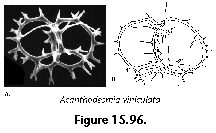 |
Acanthodesmia viniculata (Muller) (Figure 2C; 15.96) [=Giraffospyris angulata].
Shell composed of a D-shaped sagittal ring, a basal ring
and a frontal ring (see Figure 3C). Breadth of frontal
ring: ca. 140-180 Ám. Ref: Petrushevskaya
(1971a), Nigrini and Moore
(1979).
|
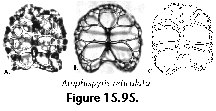 |
Amphispyris reticulata (Ehrenberg) (Figure 15.95) [=Liriospyris reticulata, ?Tholospyris
procera]. From the D-shaped sagittal ring 6 pairs of
bars arise which branch and anastomose forming the
latticed lateral walls of the shell. Breadth of shell:
ca. 230 Ám. Ref: Nigrini and Moore
(1979).
|
 |
Cephalospyris clathrobursa Haeckel (Figure 15.102). Sub-ovoid shell with very
delicate, thin wall and very small pores; main lateral
spines extend as three-bladed or hollow and perforated
feet. Shell height: ca. 200 Ám. Ref: Petrushevskaya
(1971a).
|
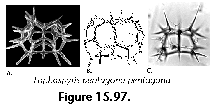 |
Lophospyris pentagona
pentagona (Ehrenberg)
(Figure 15.97) [=Lophospyris quadriforis, Lophospyris
pentagona]. Bars arising from sagittal, basal and
frontal rings define large, very regular, polygonal
pores. Skeletal bars and spines sharply three-bladed.
Breadth of shell: ca 150 Ám. Ref: Petrushevskaya
(1971a).
|
 |
Nephrospyris renilla Haeckel (Figure 15.99) [=Nephrodictyum renilla].
The front and back of the sagittal ring produce branches
that fork and anastomose distally; the two sets of
lattice plates thus formed are not interconnected
laterally. Breadth of shell: ca. 200 Ám. Ref: Petrushevskaya
(1971a), Goll (1972).
|
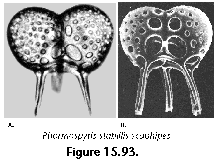 |
Phormospyris stabilis scaphipes (Haeckel) (Figure 15.93). Bi-lobulate, sagitally
constricted, thin walled skeleton with three conspicuous
feet protruding from basal ring. Breadth of shell: ca 80
Ám. Ref: Goll (1976).
|
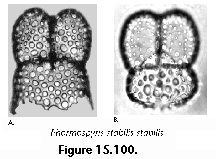 |
Phormospyris stabilis stabilis (Goll) (Figure 15.100). Cephalis thin-walled, bilobulate,
separated by a conspicuous annular constriction from the
conical thorax. Thorax open or closed. Both segmens with
regular, circular pores. Breadth of shell: ca 110 Ám.
Ref: Goll (1976).
|
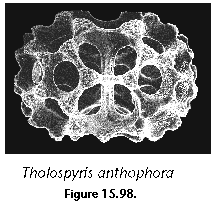 |
Tholospyris anthophora
(Haeckel) (Figure 15.98). Oval-shaped sagitally constricted
skeleton with very heavy bars and circular pores. Shell
breadth: ca. 140 Ám. Ref: Goll (1969, 1972).
|
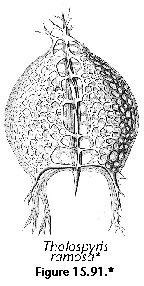 |
Tholospyris ramosa (Haeckel) (Figure 15.91) [=Androspyris ramosa].
Shell pear-shaped, sagitally constricted, with a
well-developed galea and three feet whose distal ends can
be spatulated or forked. Shell height: ca. 180 Ám. Ref: Takahashi (1991).
|
 |
Tholospyris spp. group (Figure 15.103). Rings of variable size and form
very common in most warm water materials; most of these
are probably juvenile representatives of various
Spyridae.
|
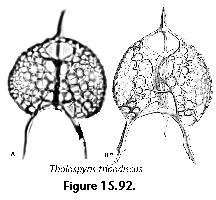 |
Tholospyris tripodiscus Haeckel (Figure 15.92). Generally similar to T. ramosa,
but with conspicuously larger pores on both sides of the
sagittal ring and at the base of the galea; feet usually
unbranched. Shell height: ca. 150 Ám. Ref: Petrushevskaya
(1971a).
|
 |
Triceraspyris antarctica (Haecker) (Figure 15.94) [=Triospyris antarctica, Phormospyris
stabilis antarctica]. Heavy bilobulated cephalis with
irregularly distributed circular pores and three massive,
simple or branched feet at the base; rudiments of
thoracic lattice often present between feet. Shell
breadth: ca. 100 Ám. Ref: Petrushevskaya (1967).
|
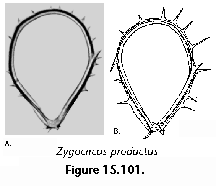 |
Zygocircus productus (Hertwig) (Figure 15.101). Pear-shaped or D-shaped, spiny,
three-bladed sagittal ring. Major diameter: 90-140 Ám.
Ref: Petrushevskaya
(1971a).
|












